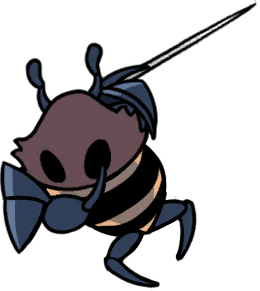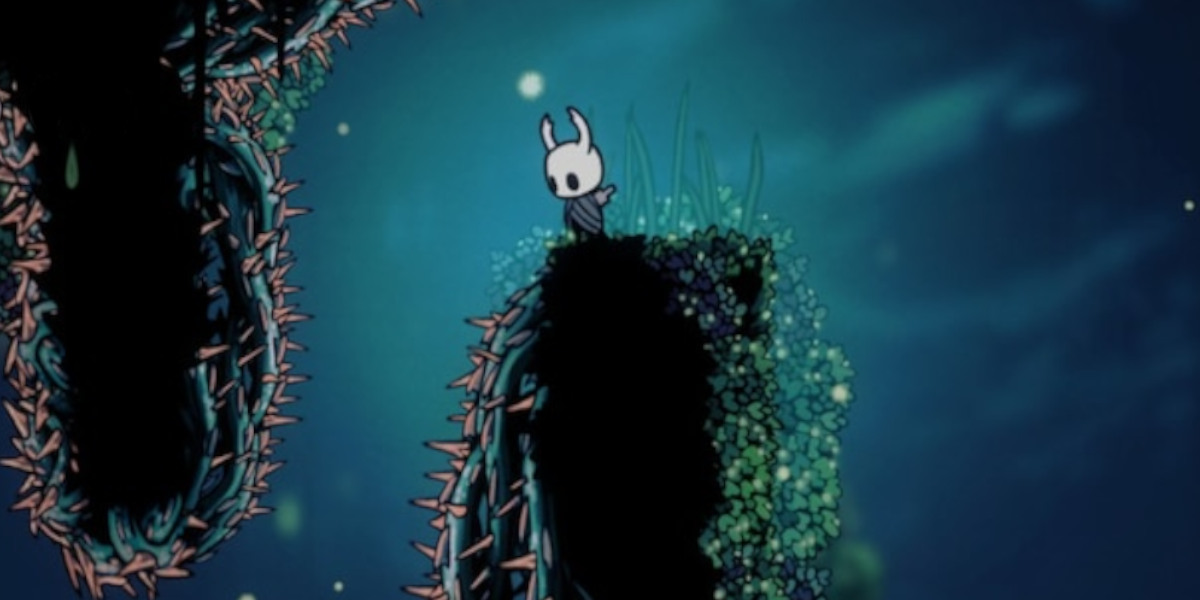Disclaimer
First and foremost, I love Hollow Knight, this game is solid with great lore, amazing art, inspiring music, and very well-tuned mechanics. That said I’m a game designer, so whenever I play a game I can’t help but dissect it and study it. I need to check its entrails and see what makes it tick and how.
This is a simple game to understand, its mechanics are transparent and clean, which makes it very easy to analyze. There’s a lot to learn about a game like this.
For this piece I want to focus on one particular aspect I dislike about the game. That doesn’t mean the game is badly done, but if I were to make a game like Hollow Knight, I would definitely take this into consideration. So I’m going to discuss what I think is a design error. During this process, I’ll try to explain why I think it is a design error and how to prevent it, which I hope is somewhat useful from a designer perspective.
Tools and lenses
Now I’m going to get ridiculously formal with this analysis. Although I do believe it’s very possible to design a game from a completely empirical process, I’ve seen it happen and with good results, I think analyzing something from an empirical process is not possible. Tools are necessary to understand what works and what not and why.
The problem with that is that the tools chosen for analysis may not fit entirely with the product, or that different tools may yield different results. Design and analysis tools are based on models and every model is imperfect in nature. So when I use my tools to review the game, the result may strongly differ from that of a different approach.
My tools for this piece are Charmie Kim’s core mechanic diagram and Hunicke, LeBlanc and Zubek’s MDA Framework.
In a very compact summary, Designing Around a Core Mechanic states that the game’s mechanics are stacked in layers. The first of them, the Core Mechanic is one that’s mandatory to play the game. That means that whenever the player is playing the game is using this mechanic and it is not even possible to play the game if not through this mechanic.
MDA is about how every game evokes a particular emotional response from the player. That experience is called an aesthetic and every game can be classified in one of 8 aesthetics (I personally work with 9, but that’s a discussion for another day).
Both lenses are completely independent, but interact nicely when applied together: the Main Aesthetic has to be supported by the Core Mechanic. What I mean by that is the Core Mechanic (and the way it’s implemented specifically for the game) is the one causing the player to feel what the Main Aesthetic pretended.
What’s the what on Hollow Knight
Hollow Knight’s Main Aesthetic is Challenge. That means the game is HAAARD. But to be more specific, the game is physically hard. To progress in this game, the player has to demonstrate they have good reflexes, eye-to-hand coordination, and muscle memory, also a good sense of rhythm helps a lot. There’s some progression (charms, nail upgrades, mask shards, vessels), but at the end of the day, these tools help the player to a very limited extent. The game gets easier over time mostly because the player is getting better at it over time. Then the game increases its difficulty by introducing new challenges that further test the player skill.
So, given that this is a Challenge Game, what’s Hollow Knight’s Core Mechanic? Well, for a game like this, it’s kind of weird, because the hardest thing this game does is the fighting. The combat system in this game is simple but deep and well crafted and every tiny enemy can become a threat for the careless player. However, you CAN play the game without fighting. By that, I don’t mean you can win the game without fighting, but there are long sections of gameplay that don’t require combat at all. What you absolutely have to do every waking second while playing this game is platforming. Even during a fight, you are forced to jump, dash and run around.
Platforming is Hollow Knight’s Core Mechanic. That’s why, to make this a Challenge Game, the platforming has to be challenging in itself. And oh boy is it challenging. There are several platforming sections in this game that made me lose my cool. I literally had to apply breathing and meditation techniques to traverse the White Palace (which I haven’t finished as of yet) and I’m definitely not going to play the Path of Pain because I have stuff to do and I simply don’t have the time to “GIT GUD”.
Funny enough I found most of the boss fights really stimulating (except for the Soul Master, I hate that guy). Some bosses kicked my ass really hard, but every time I lost a fight I could retrace my steps, check what the boss did and how to better answer. I’d then check my build, switch a few charms here and there and went back with a different strategy. Most of the time that meant I eventually got the best of the fight and emerged victorious.

For instance, the first time I fought the Hive Knight*, this guy made me cry. I just couldn’t even hit him. So I left the room, went exploring and a few hours later I came back with Sharp Shadow and Dash Master and won in the second round and with life to spare.
Something similar happened with the Mantis Lords. At first, they just owned me, but I went away, upgraded my nail, got a few new charms and went back to better results.
The design flaw
So what’s this “error” I’ve been talking about. Well here’s the bone I pick. If this game’s Core Mechanic is Platforming, that means fighting is a secondary mechanic, a very prominent one, but secondary nonetheless. The game features a ton of progression mechanics that help you fight. The nail upgrades, the spells, most of the charms are combat-oriented (with the exception of Dash Master, Sprint Master, and Sharp Shadow, I’ll talk more about this later). But very few progression mechanics help you platform, and not in the same way.
So which mechanics help with platforming and how? Well, there’s Dashing, which allows the knight to jump longer distances, Monarch Wings allows to double jump, Mantis Claw gives you wall jump and resets the ability to dash and double jump without touching the ground, Crystal Heart allows you to make an impersonation of Tom Cruise in Top Gun, Isma’s Tear allows to avoid acid damage, and Shade Cloak allows to avoid enemy damage and cross certain barriers when dashing.

Since the game is a Metroidvania, all of these mechanics open sections of the map that were previously unreachable, that’s their main reason to be. Along the way, these mechanics make platforming easier for general sections, which is very good. Added to those is pogo-ing (hitting down with the nail) which is available from the beginning of the game.
Just like the boss fights are like the pinnacle of the fighting mechanic, the game features a few platforming sections that are like “boss sections” for the platforming mechanic: Nail Master Sheo’s hut in the Green Path, The Traitor’s Child Grave in the Queens Gardens, a very irritating vessel fragment in Deep Nest (I really hate pogo-ing), Life Blood Core charm and of course The White Palace and The Path of Pain, among many others.
Here’s my problem: Why if every boss fight has several strategies to it, do these platforming sections have only ONE strategy, and that strategy is: do it perfectly or die.
Why is that an “error”
So the platforming is hard, and there are some platforming sections that are significantly harder. Why is that an “error”? A design error is a difficult thing to explain, it has to do with design intention and execution. The fact that the game behaves like that is not an accident, the awesome guys at Team Cherry intended the game to be like that and obviously designed each and every one of those sections with a lot of care and attention to detail.
What I find annoying about these sections is the fact that a secondary mechanic (fighting) got a lot of attention from the devs, with a lot of options for the player to try new strategies to overcome the challenge. Because of this, the fighting system is very deep and complex. While the platforming system is way more shallow, in spite of being the core mechanic.
The single aspect I hate the most of the way the platforming challenges are designed is the fact that if you hit spikes you get sent back to a checkpoint. I’d rather bounce back and forth in the spikes losing all my life in the process, but at least with a glimpse of hope that I could recover and keep advancing. With that little change, all the life-enhancing charms would become truly useful in these sections, suddenly there’s a real benefit from equipping Joni’s Blessing or Unbreakable Heart, other than watching yourself die in the same section more times over.

In this humble designer’s opinion, the platforming system should be as deep and complex as the fighting system. That’s what I personally consider a “design error”. Obviously they took steps to craft interesting challenges for both systems, which makes me think they realize the platforming was really important and they should feature cool platforming “bosses” in the game. So I find it a bit annoying they didn’t add more depth to it, the way they did with the fighting system.
Two types of hard
When designing a hard section of gameplay, there are two types of hard. There’s the “this is so hard you either ace it or fail it”, this means that, unless you know exactly how, you won’t solve it. And there’s the “this is so hard you’ll sweat bullets and have a heart attack while solving it”, this means it’ll maybe take a lot of time and resources, but with enough perseverance a decent player should be able to solve it in one go, one incredibly exhausting and hair-pulling go, but only one (or significantly fewer attempts for that matter).
The first type of hard is more frustrating for the average player since it’s the kind of thing that makes you fail over and over again in a very short span of time. The second type is more rewarding but brings a rhythm problem, most players will not be able to keep it up if the game is always like that. You need to give the players a moment to breathe from time to time, otherwise, they’ll get exhausted.
Hollow Knight uses both types in their boss design. There are examples like Hornet or the Mantis Lords which are easier to evade but difficult to hit. These fights are long and intense, the player has to move constantly and react to their attacks waiting for an opening to strike. It’s more likely an average player will be able to win both fights within a few attempts, but surely the one time they won was a long run and they had to pause the game afterward, drink some water and soak in their success for a second.

On the other hand, the Soul Master and the Traitor Lord hit really hard and fast, they are easier to strike but very hard to evade. An average player will have to learn their patterns by heart, probably by failing over and over again, and finally beat them in a very quick and precise round.
This variety allows the game to appeal to different kinds of players, those who don’t mind getting their ass handed many times over, but to gloat in that calculated feeling of precise gameplay and premeditated action will enjoy fighting the Soul Master. While those who are a bit more sloppy and don’t mind taking their time to understand what’s going on, but have a shorter fuse for frustration will enjoy more the first fight with Hornet.
The fact that every platforming challenge in Hollow Knight features those spikes that send you back to the last checkpoint clearly favors the first kind of hard and never the second. That means the player that likes precise gameplay will enjoy a lot of these sections, but the other player, the one that takes their time will only sigh in frustration when they see a pit and hear the music change at the start of a platforming challenge (awesome soundtrack btw, except for the White Palace, those saws are annoying).
How to fix it?
I don’t pretend to teach game design to the good guys at Team Cherry. I mean, I know this whole piece is about how a very particular aspect of their game is “”””wrong””””, but at the same time, the game is incredibly solid and well designed. The only reason I was bothered by the fact that the platforming of the game is not as deep as the fighting is that I am a game designer myself and can’t help to be bothered by that kind of thing.
My intention with this piece is to register for myself (and any other designer that stumbles upon this website) how to improve over the already very good craft that Team Cherry gave us with Hollow Knight.
However, that sentiment would be hypocritical if I don’t offer at least one way to “solve” the perceived problem. So I have a few ideas, things I’d try if I ever develop a game like Hollow Knight.
The first resource I would’ve used is the most obvious one: The Charms. As I mentioned before, there are only three charms that affect the platforming system: Dash Master that allows the player to dash downwards, and is utterly useless by itself. Sprint Master which makes the Knight run faster (way faster if combined with Dash Master). Sharp Shadow that besides damaging enemies when dashing through them, also increases the length of the dash when combined with Dash Master (Dash Master is only useful when it’s modifying other charms, it’s proper effect is meh).
I feel it’d had been really easy to include a charm that allows the Knight to jump higher, dash upwards (my favorite), or to triple jump, and to lock it in a place only accessible by the player after they get the Monarch Wings. Also, a charm that allows the player to bounce off spikes, maybe even taking damage while doing it, but avoiding the pain of getting sent back to the last checkpoint.
The second resource is one that I really don’t understand why is a restriction (I suppose during playtest they found it to be problematic in some way): Allow the player to Shadow Dash through environmental obstacles and hazards. Imagine that combined with an upwards dash, the general platforming in the late-game would become extremely agile and satisfying. Challenges like the fragile flower would change from ridiculously hard to mildly frustrating in a snap.
Finally, I’d look for a way to design platforming sections that are by nature the second type of hard. Maybe taking more advantage of wall-jumping and the Crystal Heart and featuring less godawful spikes everywhere. There’s a section in the Fog Canyon that features lots of explosives everywhere. I thoroughly enjoyed that section because it allowed me to take my time to solve it step by step, using different tools. Also, the singing trees sections were very enjoyable for me, for the same reason, not exactly a challenge, but a fun piece of gameplay anyway.
If I had to choose, I honestly prefer the solution with the charms, because that’s how to give the system more dept, in turn giving more agency to the players on how to overcome the different challenges. That way the frustration of one section can translate to an AHA! moment when the player finds a different strategy that works better for them, allowing them to come back and tackle the challenge with renewed strength and enjoy a section that previously caused them anguish.
TL;DR:
When designing a game it’s really important to be clear on what is your core mechanic. Once identified, it’s important to create dept for this mechanic first, before supporting other secondary mechanics, no matter how prominent they are (the core mechanic by nature will always be the more prominent in the game).
It’s also important to make sure your game features diversity in its challenge structure. Playing the same scenario over and over again can get frustrating, even for the most loyal niche player you have.

